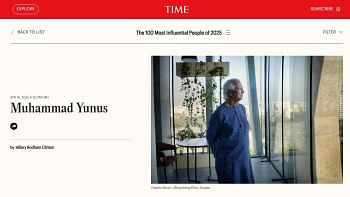How to mitigate the impact of Trump’s reciprocal tariffs

The United States government's decision on reciprocal tariffs has sent shockwaves through financial markets and reverberated through economies worldwide. On April 2, the US introduced a sweeping tariff policy, imposing a baseline 10 percent reciprocal tariff on all imports and even higher country-specific tariffs. Bangladesh faced a crippling 37 percent tariff on its exports to the US. This new tariff regime not only sparked a global market crash but also ignited diplomatic and economic turmoil. Of course, a 90-day pause in the tariff decisions was placed within a week.
The market reaction was just one factor among several influencing the temporary change of decision on the tariffs. Growing political concern, both within the US and among international trading partners, has also been an issue. Many industry leaders and governments voiced unease over the economic uncertainty caused by these new tariffs. Concurrently, diplomatic negotiations took place, especially with countries that had avoided retaliatory measures. These combined factors led to the temporary suspension of tariffs on April 9 for more than 75 countries, while maintaining—and in some cases strengthening—the measures specifically directed towards China.
The US decision to impose a 145 percent tariff was met with a retaliatory 125 percent tariff from China on American goods. This tit-for-tat dynamic suggests that what was once a strategic economic rivalry has now spiralled into a trade war with far-reaching global consequences, where collateral damage is inevitable. For smaller export-dependent economies like Bangladesh, which are plugged into global supply chains through their economic activities, the repercussions are significant.
Bangladesh's trade in goods with the US is about $10.6 billion. In 2024, our total goods exports to the US were $8.4 billion, and imports from the US amounted to $2.2 billion. The additional 37 percent reciprocal tariff, if put into effect, presents a threat to Bangladesh's exports, especially its RMG sector, which is its economic lifeblood. RMG exports account for more than 85 percent of the country's exports to the US. Though a Least Developed Country (LDC), Bangladesh has not been allowed duty-free, quota-free (DFQF) market access for its RMG to the US since 2013. The country has already been paying a 15 percent tariff for its RMG products to enter the US market.
The new tariff regime will make Bangladeshi goods significantly more expensive in the US. As a result, US buyers may opt for suppliers from countries not subjected to the same tariff burdens—and Bangladesh risks losing market share in one of its most critical export destinations. The price shock could be absorbed by US buyers and Bangladeshi exporters to shield consumers from high prices. But whether, and by how much, the increased cost will be shared by exporters and importers is uncertain.
The RMG sector is not only the engine of Bangladesh's external economy but also an important source of employment. Therefore, the consequences of these tariffs for the RMG industry cannot be ignored. A reduction in orders from US retailers due to higher prices could force factories to cut back on production. In a labour-intensive industry, this will lead to job losses. Such a reduction could also have social ramifications—from rising unemployment and poverty to increased pressure on public services and social safety nets.
Beyond the direct impact on exporters and workers, high tariffs also threaten to disrupt Bangladesh's macroeconomic stability. Lower export earnings could lead to a widening trade deficit and reduced foreign exchange reserves. Additionally, the anticipated decline in US demand could push Bangladeshi manufacturers to slash profit margins and invest less in innovation, skills, and sustainability measures.
Following the US tariff announcement, the Bangladesh government wrote a letter to the US president on April 7 requesting the US to postpone the implementation of the tariffs for three months. Bangladesh has signalled a willingness to import more US products, including agricultural commodities like cotton, wheat, and soybeans, in an attempt to reduce the existing trade deficit.
One of the unfinished tasks has been developing a robust export sector in Bangladesh through diversification of both export products and markets. Dependency on a single export product is a weak trade strategy, as it is subject to vulnerability from both domestic and external shocks. Product diversification also includes the expansion of items within the RMG industry. Beyond RMG, leather products and pharmaceuticals also have a higher export potential. Diversification of markets will also help buffer against trade shocks to some extent. Moreover, Bangladesh must continue to invest in enhancing the quality and value of its products through improved designs, sustainability certifications, and compliance with international labour and environmental standards to maintain its competitive edge.
Since powerful countries have consistently undermined the rule-based multilateral trading system over the years, the objective of the World Trade Organization (WTO) to promote open and fair trade globally by reducing or eliminating tariffs has been facing challenges. Therefore, WTO member-states have resorted to plurilateral and bilateral trade agreements. Bangladesh is lagging behind in this regard. We should negotiate free trade agreements (FTAs) with our trading partners to prepare a robust trade sector. Countries such as Vietnam and Cambodia, which also export RMG products, have moved far ahead in this regard, enhancing their market access and export competitiveness.
Bangladesh should aggressively pursue FTAs that will offer tariff-free or reduced-tariff access to other markets. Strengthening its presence in regional trade blocs like BIMSTEC and deepening engagement with ASEAN economies could open new pathways for trade growth and regional integration. To achieve these objectives, the government must also align domestic policies with international standards, particularly concerning labour rights and environmental regulations. A thorough review of its tariff structures is also important. This is especially so as the country will graduate from LDC status in November 2026—when it will no longer enjoy non-reciprocity of tariff measures with its trading partners.
As part of trade policy reform, Bangladesh should demonstrate its commitment to fair trade by reducing non-tariff barriers (NTBs) and improving customs facilitation. Capacity-building across industries—via training programmes, technology adoption, and quality assurance mechanisms—will be essential to elevate the country's exports beyond price sensitivity.
The 90-day window is, therefore, an opportunity for Bangladesh to prove its diplomatic agility, economic foresight, and institutional capacity to respond to external shocks. Of course, it will take a long time to implement trade reforms. But if worked on systematically, Bangladesh can turn this challenge into a catalyst for transformation. It can leverage this critical moment for sustainable growth that is less dependent on preferential access and more rooted in innovation, diversification, quality, and productivity.
Dr Fahmida Khatun is executive director at the Centre for Policy Dialogue (CPD). Views expressed in this article are the author's own.
Views expressed in this article are the author's own.
Follow The Daily Star Opinion on Facebook for the latest opinions, commentaries and analyses by experts and professionals. To contribute your article or letter to The Daily Star Opinion, see our guidelines for submission.

 For all latest news, follow The Daily Star's Google News channel.
For all latest news, follow The Daily Star's Google News channel. 










Comments